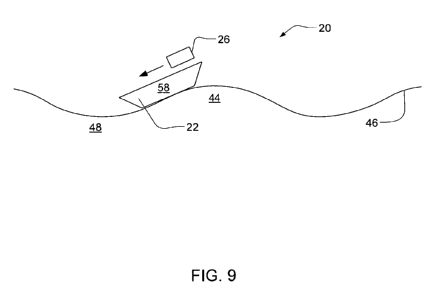Note: Descriptions are shown in the official language in which they were submitted.
. .
CA 02809577 2013-02-26
WO 2012/018392
1
PCT/US2011/001368
SYSTEM FOR PRODUCING ENERGY THROUGH THE ACTION OF WAVES
CROSS-REFERENCE TO RELATED APPLICATIONS
5 This application is a continuation-in-part of
U.S. Patent Application No. 12/316,772
filed on December 15, 2008, continuation-in-part of U.S. Patent Application
No. 12/079,591
filed on March 27, 2008 which is a continuation-in-part of abandoned U.S.
Patent
Application No. 11/593,895 filed on November 7, 2006 which claims the benefit
of U.S.
Provisional Patent Application 60/734,203, filed November 7, 2005, which are
incorporated
10 herein by reference.
FIELD OF THE INVENTION
The present invention is a system and method for producing electricity. More
particularly, it is a system and method for producing electricity through the
action of waves
15 on platforms.
BACKGROUND OF THE INVENTION
There are numerous approaches to producing electricity from the hydraulic
force of
the localized movement of water in large bodies of water. Water moving as a
result of tides,
20 winds, or gravity, for example, has been used as a hydraulic
force to move some turbine,
door, or other part of a larger apparatus anchored to land. This approach is
expensive, not
very efficient, and prone to breaking down both because of the difficulty in
anchoring the
apparatus to land and because the ocean is corrosive and small sand particles
in the ocean
cause excessive wear.
25 The power density of wind and water, two
abundant natural resources, is very low.
It is not until wind is blowing in excess of 100 MPH that it will blow a
standing person
over, and if a person is floating in even large ocean waves the force of the
waves flows by
you because water is a low-density liquid. One can feel the energy of the
wave, but the
force is minimal as compared to standing in the road and being hit by a bus
traveling at the
30 same speed as the wind or water. Force equals the density of
an object multiplied by the
speed that it is traveling, so very low-density substances like wind and water
do not make
very good energy resources because the scale of energy projects for wind and
water have to
be extremely large and expensive and can also have extensive environmental
impact on our
planet, such as large hydro projects.
